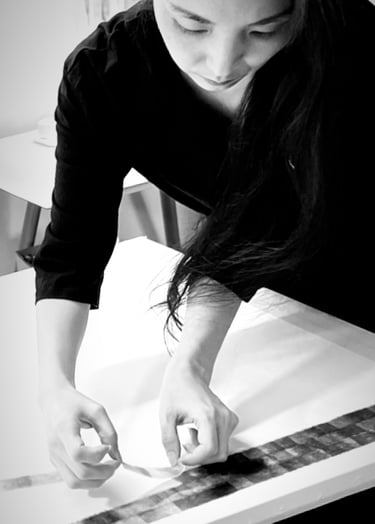BoYoung Jung (Gwangju, b.1978) is a Korean artist whose practice explores the temporal and spatial dimensions of living experience, memory, and identity. Her philosophical inquiries began with sculptural woodwork and bronze work, particularly her tree-based sculptures, which cultivated an intuitive understanding of trees as living entities embodying cycles of repetition and transformation. Through ink on mulberry Hanji paper, collage, and textiles, Jung’s work meditates on the continuous flow of lived existence and the constant process of becoming. Reflecting on the bodily experience of time and the interconnectedness of different experiences and environments, her works are built through meditative, repetitive mark-making and the layering of various visual dimensions. Jung has also maintained a long-term sculptural collaboration with Belgian artist Emmanuel Wolfs under the WOLFS+JUNG label, exploring philosophical concerns across different material and cultural contexts.
정보영 (광주, b.1978)은 삶의 경험, 기억, 그리고 정체성의 시간적, 공간적 차원을 탐구하는 한국 작가입니다. 그녀의 철학적 탐구는 목조 및 브론즈 작업, 특히 나무를 소재 및 주제로 한 조각작업에서 시작되었고, 이 작업들을 통해 그녀는 반복과 변형의 순환을 구현하는 살아있는 존재로서의 나무에 대한 직관적인 이해를 발전시켰습니다. 한지에 먹을 사용한 작업, 콜라주, 직물작업 등을 통해 정보영 작가는 끊임없이 흐르는 삶의 존재와 '되어감(becoming)'의 지속적인 과정에 대해 사유합니다. 작가는 그리는 과정속에서 시간의 신체적 경험과 환경의 상호 연결성을 반영하며, 명상적이고 반복적인 선긋기 및 다양한 시각적 차원들을 겹쳐 쌓는 방식으로 구축됩니다. 또한, 정보영 작가는 벨기에 작가 엠마뉴엘 울프스(Emmanuel Wolfs)와 함께 'WOLFS+JUNG'이라는 이름으로 장기간 조소 작업 협업을 이어오며 다양한 재료와 문화적 맥락에서 철학적 관심사를 탐구해 오고 있습니다.



